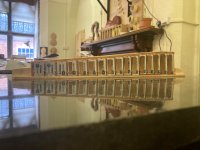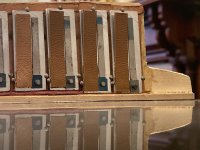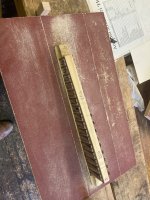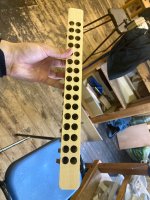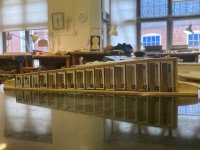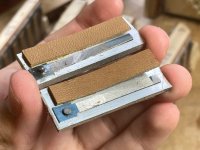Squeezebox Of Delights
Active member
So a few days ago I posted this thread -
https://www.accordionists.info/threads/whoopsy-daisy-i-bought-a-cba.14638/ - regarding my acquisition of a beautiful but typically unplayable 1930s Paolo Rogledi accordion. I am becoming increasingly fond of this box, and have decided to start a thread purely dedicated to the slow and intermittent refurbishment journey I have embarked upon.
Today I decided to address a glaring issue that was responsible for most of the instrument's wheeziness and air-hungriness. All 5 reed blocks had bowed considerably in the 94 years since they were made, meaning adjacent notes all played together and the notes I was trying to play were quiet with a slow and weak attack, all while using a huge amount of air. I took them out of the instrument and marked the bases in pencil, before sanding each one on a reliably flat sanding board until the marks were no longer visible. It's worth noting that I am aware that the reeds should probably usually be removed first, but they'll all be coming off at some point to be thoroughly cleaned anyway! I checked each one against an engineer's granite block, before cleaning them up and reinstalling them. All, that is, except for the MM block for the third/sixth row, on which the base has separated from the walls. I intend to glue it back together with hide glue before giving it the same treatment as the others. This means that the third and sixth rows are still quite weak and wheezy. The other rows are now wonderfully loud and clear, despite the original, long dried-out valves, and the instrument is nearly playable.
Of course, theoretically playable is very different to actually playable, and once the last reed block has been flattened I will still need to remove and clean all the reeds, replace the valves, tune them, replace and repair several parts of the instrument that are broken/missing, level the buttons... the list goes on. Still, I'm happy with the first step!
https://www.accordionists.info/threads/whoopsy-daisy-i-bought-a-cba.14638/ - regarding my acquisition of a beautiful but typically unplayable 1930s Paolo Rogledi accordion. I am becoming increasingly fond of this box, and have decided to start a thread purely dedicated to the slow and intermittent refurbishment journey I have embarked upon.
Today I decided to address a glaring issue that was responsible for most of the instrument's wheeziness and air-hungriness. All 5 reed blocks had bowed considerably in the 94 years since they were made, meaning adjacent notes all played together and the notes I was trying to play were quiet with a slow and weak attack, all while using a huge amount of air. I took them out of the instrument and marked the bases in pencil, before sanding each one on a reliably flat sanding board until the marks were no longer visible. It's worth noting that I am aware that the reeds should probably usually be removed first, but they'll all be coming off at some point to be thoroughly cleaned anyway! I checked each one against an engineer's granite block, before cleaning them up and reinstalling them. All, that is, except for the MM block for the third/sixth row, on which the base has separated from the walls. I intend to glue it back together with hide glue before giving it the same treatment as the others. This means that the third and sixth rows are still quite weak and wheezy. The other rows are now wonderfully loud and clear, despite the original, long dried-out valves, and the instrument is nearly playable.
Of course, theoretically playable is very different to actually playable, and once the last reed block has been flattened I will still need to remove and clean all the reeds, replace the valves, tune them, replace and repair several parts of the instrument that are broken/missing, level the buttons... the list goes on. Still, I'm happy with the first step!

